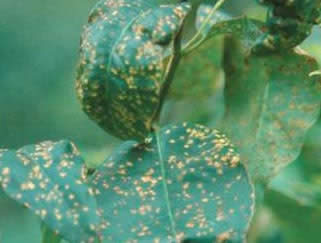
 |
Eucalyptus
Rust causing light coloured dead spotson Eucalypt
leaves |
|
Report suspect detections to your local department of agriculture or prinary industry Call the Eexotic Plant Hotline 1800 084 881 For more information visit Plantpesthotline |
Eucalyptus Rust (also known as Guava Rust), Puccinia psidii, is a fungal pathogen which originates from Central and South America. It attacks young stems and shoots of plants in the Family Myrtaceae, forming rusty pustules which in turn produce a multitude of wind-borne spores. The pathogen is not yet in Australia but has already knocked at our door - in 2004 it was detected pre-border on wood imported from Brazil. Australian pest authorities believe there is a strong likelihood that an incursion of the pest into Australia will occur at some time.
Eucalyptus Rust is extremely destructive to young plants, and can destroy young tissue in mature trees.
Australia has approximately half of the world’s 147 genera and 3,000 species of Myrtaceae. More Australian native plant species belong to the Myrtaceae than to any other family. Myrtaceae are dominant species in many of the major Australian ecosystems, from tall forests to swamps and wetlands. Out of 83 native Australian Myrtaceae species tested overseas for susceptibility to Eucalyptus Rust to date, 73 species show some degree of susceptibility.
For Australia, this would mean that genera such as Eucalyptus, Corymbia, Melaleuca and Syzygium may be at risk. The effect of this disease on new Australian hosts may be far more unpredictable than on hosts that have a long association with the pathogen – it is difficult to predict the impact of Eucalypt Rust on our biodiversity.
Syzygium appears to be a particularly susceptible host - even in the driest regions in Brazil, Syzygium is always attacked.
Overseas experience shows that Eucalyptus Rust spreads very rapidly – late last year it spread from one island to all of the Hawaiian islands in just 3 months.